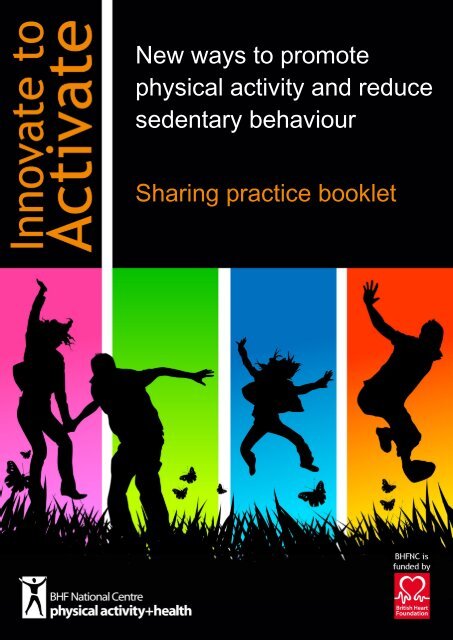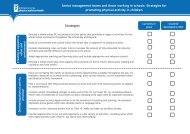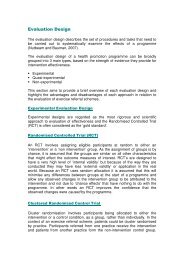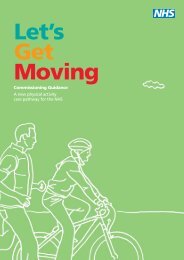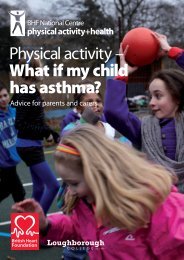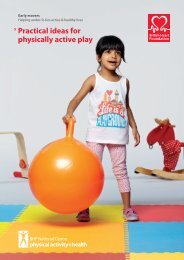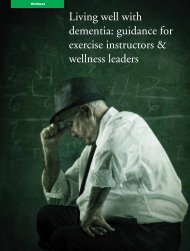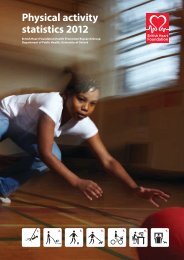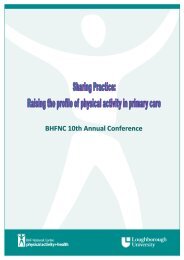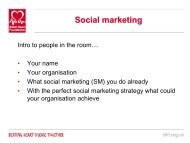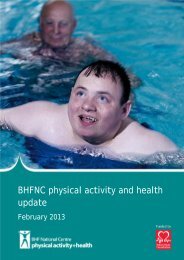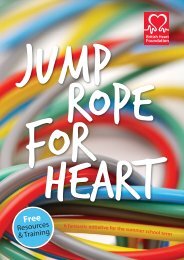Innovate to Activate sharing practice booklet - BHF National Centre ...
Innovate to Activate sharing practice booklet - BHF National Centre ...
Innovate to Activate sharing practice booklet - BHF National Centre ...
Create successful ePaper yourself
Turn your PDF publications into a flip-book with our unique Google optimized e-Paper software.
New ways <strong>to</strong> promotephysical activity and reducesedentary behaviourSharing <strong>practice</strong> <strong>booklet</strong>
2 Sharing <strong>practice</strong> <strong>booklet</strong>About usThe <strong>BHF</strong> <strong>National</strong> <strong>Centre</strong> for Physical Activity and Health (<strong>BHF</strong>NC) was established in 1999 andis funded by the British Heart Foundation. We are also part of the prestigious School of Sport,Exercise and Health Sciences at Loughborough University.The <strong>BHF</strong>NC is well recognised across the UK for its leadership in the promotion of physicalactivity and health. We are committed <strong>to</strong> developing and translating research evidence <strong>to</strong>improve and extend the <strong>practice</strong> of promoting physical activity in the UK.We do this by supporting professionals across a range of sec<strong>to</strong>rs including health care,education, transport, sport and leisure with practical <strong>to</strong>ols <strong>to</strong> promote physical activity.To find out more about the work we do visit our website www.bhfactive.org.uk
<strong>Innovate</strong> <strong>to</strong> <strong>Activate</strong> 3ContentsAbout this <strong>booklet</strong> 4Case studies 5ACTIVE – Active Children Trough Incentive Vouchers 5Active Together Workplace Challenge 7Does exergaming augment lunchtime physical activity in primary school children? 9Fidget Project 11Greenwich Get Active 13healthCAL 15The use of social media techniques <strong>to</strong> promote the viral vide ’23½ hours’ <strong>to</strong> 17Arabic speaking countries at risk of non-communicable diseases through physicalinactivityWalk <strong>to</strong> School Campaign 19Electronic Play Equipment Makes Fitness Fun 21Activ8 Road 2 London 23‘Active Health’ Physical Activity Referral Programme 25Be Active 27Cornwall Beach Games 29Get Active Cornwall Challenge 31GPS Orienteering – Put yourself in the computer game 33Walking Towards Better Health 35Wii Fit 37
4 Sharing <strong>practice</strong> <strong>booklet</strong>About this <strong>booklet</strong>This <strong>booklet</strong> includes examples of innovative physical activity projects and programmes, someof which were displayed at the 12th <strong>BHF</strong>NC annual conference, <strong>Innovate</strong> <strong>to</strong> <strong>Activate</strong> – newways <strong>to</strong> promote physical activity and reduce sedentary behaviour.The case studies summarised in this <strong>booklet</strong> are examples of physical activity interventions,programmes and research studies which directly use: new or emerging technologies interactive exergaming mass or social media active assistance or interactive assistance technology innovative approaches.This information <strong>sharing</strong> <strong>booklet</strong> contains details of health and wellbeinginitiatives and projects developed and or managed by all manner oforganisations, companies, firms and individuals (participating parties), inrelation <strong>to</strong> which the British Heart Foundation (<strong>BHF</strong>) and the <strong>BHF</strong> <strong>National</strong><strong>Centre</strong> for Physical Activity and Health (<strong>BHF</strong>NC) have not had any inputand do not exercise any control.Accordingly, the <strong>BHF</strong> and <strong>BHF</strong>NC confirm for the avoidance of any doubtthat they do not accept any legal liability relating <strong>to</strong>, or arising from anyinitiatives and/or projects, that they are not recommending any suchinitiatives or projects and that they are not endorsing and products orservices offered by any of the Participating Parties.
<strong>Innovate</strong> <strong>to</strong> <strong>Activate</strong> 5Case studiesACTIVE - Active Children Through Incentive VouchersSwansea UniversityAim(s) and objectivesThe project aims <strong>to</strong> assess the feasibility of theACTIVE voucher scheme via focus groups whileassessing the effect on participation in exerciseand fitness.OverviewACTIVE is a mixed method study, funded by theBritish Medical Association assessing thefeasibility of a voucher scheme in increasingphysical activity amongst adolescents.Participants included 115 Year 9 pupils,13-14years old, from a secondary school in a deprivedarea of Swansea. Each Year 9 pupil received £25 vouchers per month for six months <strong>to</strong> spendeither on existing activities at leisure centres, <strong>to</strong> buy sports equipment or <strong>to</strong> employ newcoaches.Twenty-two activity providers from the local Swansea area agreed <strong>to</strong> participate in the studyallowing a wide range of activities on which the vouchers could be spent ranging from thewaterpark <strong>to</strong> 5-a-side football pitches and climbing walls <strong>to</strong> sports shops.All vouchers were filled in by participants on transaction and activity providers invoiced theuniversity at the end of each month for the number of vouchers spent, paid on a 100% reclaimbasis and managed by the facilita<strong>to</strong>r. Vouchers were then digitalised forming an electronicdatabase of voucher usage.Evaluation/research methodologyThe intervention ran from January 2012 <strong>to</strong> July 2012, with three weeks in December 2011 forbaseline testing. This included physical activity measures (PAQ-A questionnaires, GENEACTIVaccelerometers) and fitness testing (Cooper 12-minute run). Motivation <strong>to</strong> exercise wasmeasured as a confounding variable in April 2012 and seven focus groups were undertakenthroughout <strong>to</strong> determine thoughts on the project. Physical activity and fitness measures weretaken in June 2012 and follow-up measurements are due in December 2012.A facilita<strong>to</strong>r under<strong>to</strong>ok all testing and distributed vouchers every month during school assemblyfor six months. They were also available at least once a week for the duration of the project<strong>to</strong> assist participants with any queries.
6 Sharing <strong>practice</strong> <strong>booklet</strong>Focus groups were carried out pre-intervention, during and after <strong>to</strong> qualitatively assess theparticipant’s views of the scheme and how it had impacted on their physical activity levels aswell as their opinions on the feasibility of such a scheme.ResultsEarly results showed a child-matched significant increase in physical fitness (p
<strong>Innovate</strong> <strong>to</strong> <strong>Activate</strong> 7Active Together Workplace ChallengeLeicester-Shire & Rutland SportAim(s) and objectives of the projectThe Active Together Workplace Challenge aims <strong>to</strong>encourage behaviour change <strong>to</strong> increase participation insport and physical activity. It uses an Activity Log as amotivational <strong>to</strong>ol <strong>to</strong>gether with the development of acompetition programme of events and business games.Overview of the projectThe Active Together Workplace Challenge is delivered byLeicester-Shire & Rutland Sport (LRS) as part of the ActiveTogether programme, which consists of a range ofpartners across Leicestershire and Rutlandinterested in the development of physical activityand sport. It is designed <strong>to</strong> encourage and supportworkplaces, of all sizes, across Leicestershire,Leicester and Rutland <strong>to</strong> promote increasedparticipation in physical activity and sport amongall their staff, especially those who do little or no activity.The project is focused around a web-based <strong>to</strong>ol (www.workplacechallenge.org.uk), linked <strong>to</strong>the Leicester-Shire & Rutland Sport website. The site allows individuals and organisations <strong>to</strong>log participation in sport, physical activity and active travel, view leader boards and livestatistics, register for inter workplace competitions and find out more about workplace health.In addition <strong>to</strong> the web-based <strong>to</strong>ol, a programme of inter workplace sports competitions isorganised in partnership with <strong>National</strong> Governing Bodies. An annual Business Games event isalso an integral part of the workplace challenge.Evaluation/research methodologyParticipants complete an initial registration questionnaire, log their activity over the course ofthe challenge and complete an evaluation questionnaire. Assessment of physical activity isincluded in both the registration and evaluation questionnaires.Following the workplace challenge activity log (three months) a post challenge evaluationsurvey is completed. Using participation data and findings from the evaluation survey,Leicester-Shire & Rutland Sport work in partnership with Loughborough University <strong>to</strong> completea moni<strong>to</strong>ring report and <strong>to</strong> produce recommendations for future challenges.The evaluation survey is used <strong>to</strong> moni<strong>to</strong>r participation in physical activity and <strong>to</strong> gain feedbackfrom participants regarding the programme.
8 Sharing <strong>practice</strong> <strong>booklet</strong>In the long term the Workplace Challenge aims <strong>to</strong> engage more participants and workplacesand <strong>to</strong> continue <strong>to</strong> demonstrate an increase in participation through both proxy measures andthe Active People Survey.Results of the projectIn 2011, 827 participants <strong>to</strong>ok part from 67 workplaces. The percentage of participantsachieving the recommended 150 minutes of physical activity increased from 34% at registration<strong>to</strong> 47% in the post challenge evaluation.In 2012 165 workplaces <strong>to</strong>ok part with 1,172 participants. The percentage of participantsachieving the recommended 150 minutes of physical activity increased from 32% at registration<strong>to</strong> 62% in the post Challenge evaluation.Tips for other professionals1. Find a workplace champion and secure buy in from the management team.2. Target workplaces from all sec<strong>to</strong>rs, in order <strong>to</strong> engage more workplaces.3. Clearly communicate physical activity guidelines.Contact Andrew WatsonKim LillieEmail a.watson4@lboro.ac.ukEmail k.lillie@lboro.ac.uk
<strong>Innovate</strong> <strong>to</strong> <strong>Activate</strong> 9Does exergaming augment lunchtime physical activity in primaryschool children? A comparison between the Nintendo Wii and theGamercize Power StepperCoventry UniversityAim(s) and objectives of the projectThe aim of this study was <strong>to</strong> examine thepotential for active videogaming <strong>to</strong> contribute <strong>to</strong>physical activity during school lunch breaks.The objectives of the study were <strong>to</strong> assessphysical activity levels during active video gameplay over a six week period using two differentactive video game systems, the Nintendo Wii andthe Gamercize Power Stepper, and compare this<strong>to</strong> ‘free play’ associated with break time activityin a sample of British primary school children.Overview of the projectIt has been suggested that exergaming may offer an alternative means by which children canbe physically active but few studies have examined this issue in ‘real world’ settings. Thisstudy sought <strong>to</strong> assess physical activity (PA) levels during two modes of exergaming andcompare this <strong>to</strong> ‘free play’ associated with lunch break activity in a sample of British primaryschool children. Fifty-one children (ages 10-11 years) from central England were randomlyselected <strong>to</strong> participate in a six week, lunchbreak based, exergaming intervention. Childrenparticipated in twice weekly exergaming sessions (run by community volunteers) using theNintendo Wii (n=17), Xbox 360 and Gamercize Power Stepper (n = 17) or acted as controls(n=17) engaging in traditional lunchbreak activity only.Evaluation/research methodologyThe study used children from three primary schools in England who were randomly allocated <strong>to</strong>intervention or control groups.Two intervention groups each under<strong>to</strong>ok twice weekly active video gaming sessions duringschool lunch breaks for six weeks. One group engaged in Nintendo Wii based activity and theother engaged in Gamercize Power Stepping activity with an XBOX360. A control groupparticipated in their ‘regular’ lunch break activity.PA was assessed via pedometry and heart rate moni<strong>to</strong>ring (from which time spent in moderate<strong>to</strong>-vigorousPA was determined).
10 Sharing <strong>practice</strong> <strong>booklet</strong>Results of the project Children in the Nintendo Wii group participated in significantly less physical activityacross the six week period compared <strong>to</strong> the Gamercize Power Stepper and Controlgroups (P = .0001).There were no significant differences in physical activity between Gamercize PowerStepper and control conditions.There were also no significant differences in the percentage of time spent inmoderate-<strong>to</strong>-vigorous physical activity across groups or over time.Active video game play at lunchbreaks, using the Gamercize power stepper, appears <strong>to</strong>be similar <strong>to</strong> physical activity levels during traditional school lunchbreak over a sixweek period.Active gaming using the Nintendo Wii resulted in significantly less physical activitycompared <strong>to</strong> traditional lunchbreak.Exergaming may therefore provide an alternative means <strong>to</strong> engage children in physical activityin the school setting but consideration should be given <strong>to</strong> the gaming platform employed byteachers and practitioners wishing <strong>to</strong> use videogaming in schools <strong>to</strong> promote health enhancingPA.Tips for other professionals1. The exergaming console used in any intervention plays a key role in the PA responses.2. In the context of school break times, exergaming technology could offer an alternativeopportunity for children <strong>to</strong> engage in physical activity, particularly for children who arenot attracted <strong>to</strong> other more traditional modes of PA.3. Exergaming as an intervention mode <strong>to</strong> enhance PA may not be equally effective inenhancing physical activity in all children and may be better targeted at subgroups ofchildren (eg, obese boys)Contact Dr Mike DuncanEmail michael.duncan@coventry.ac.uk
<strong>Innovate</strong> <strong>to</strong> <strong>Activate</strong> 11Fidget ProjectLondon Arts in Health ForumAim(s) and objectives of the projectThe Fidget Project aimed <strong>to</strong> develop a fun, simple andeasy communication programme that encouragedpublic engagement with the benefits of physicalactivity and reducing sitting time.Overview of the projectFidget was a health and science communication projectdesigned <strong>to</strong> promote physical activity. The projectbrought a fusion of science and entertainment <strong>to</strong> thepublic arena, embracing innovative strategies foronline and offline communication.There were four strands of activity embedded withinthe communication programme.Strand 1. The Fidget Road Show: an interactive exhibition designed by the imminent publicartist Michael Pinsky <strong>to</strong>ured <strong>to</strong> nine venues around the UK during the summer of 2012. Itpeaked at approximately 1,000 members of the general public interacting with the installationat Bris<strong>to</strong>l Harbour Festival. The exhibition included a selection of interactive screens thatchallenged the viewer <strong>to</strong> embrace active viewing. The installation was staffed by a team oftrained communica<strong>to</strong>rs from science and performing backgrounds.Strand 2. Start22: a campaign raising awareness about the benefits of adding 150 minutes ofactivity <strong>to</strong> your week (22 minutes per day). The Start22 promotional video received over 3,400hits in a 12 week campaign. Facebook activity included user generated blogs discussingphysical activity, competition entries suggesting activities and a series of Facebook profile tagsfor people <strong>to</strong> share.Strand 3. Printed and radio press campaign: a series of interviews and articles discussingphysical activity in national and international press. Highlights include broadsheet coverage inthe UK surrounding the <strong>to</strong>ur and air time on both national and local radio, including Radio 4and World Service’s Health Check.Strand 4. Youth Council, Youthnet and YMCA Focus groups: these were semi-structured smallgroup sessions introducing the agenda for physical activity and exploring strategies for youthengagement.
12 Sharing <strong>practice</strong> <strong>booklet</strong>Evaluation/research methodologyEvaluation has been defined by reach of the communiction campaign with a qualitative reviewof content. The communication programme focused on creating awareness and discussion.With a fusion of science and entertainment the project’s success was defined in terms offootfall, online reach, review comments and feedback from focus groups.Results of the projectThe Start22 campaign ran for 12 weeks attracting over 30,000 active campaign users with anaudience reach of 28 million. The most popular items were exercise polls with 3,757participants and 1,413,441 viewers. Articles and promotional videos received 2,359 and 52,579views respectively. Evidence of higher levels of engagement were recorded throughcompletion of personal activity questionnaires (n=798) and blog contributions with 62 usergenerated blogs including 24 video blogs.Focus groups discussed campaign quality and 232 people completed a feedback questionnaire,193 of which were from 15 -25 year olds. Over 50 percent of the audience strongly agreed thatthe campaign increased understanding about physical activity and learnt more ways ofincluding moderate activities <strong>to</strong> their daily routine.Engagement with the interactive exhibition and its communication team is estimated at 2,500people over nine venues. This ranged from 70 <strong>to</strong> 500 people per day depending on venue andweather.Using Google Analytics for www.fidgetproject.org there were 6,150 unique views with theaverage time on the site being 1 min 20 sec.The Fidget project was included in over 80 pieces of journalism with audience reach reportedas far flung as India and Singapore.Critical recognition was achieved with inclusion in the review magazine ‘The Week’ with over350,000 readers. Radio interviews included Radio 4’s Winifred Robinson on You & Yours andClaudi Hammond’s Health Check on the World Service.Tips for other professionals1. Good interpersonal and communication skills within the project team will definesuccess.2. Recruiting and training staff for public facing roles should ideally involve assessmentdays. Recruitment for the Fidget communications team was completed in three stagesincluding individual interviews and group assessments.3. Stakeholder engagement is time consuming and requires patience. Allow lead times ofup <strong>to</strong> three months <strong>to</strong> accommodate for the transition from initial emails andtelephone calls, <strong>to</strong> face time before expecting collaborative partnerships.Contact Dr Wilby WilliamsonEmail wilby@lahf.org.uk
<strong>Innovate</strong> <strong>to</strong> <strong>Activate</strong> 13Aim(s) and objectives of the projectGreenwich Get Active aims <strong>to</strong> increase thenumber of local people being physicallyactive within the Borough of Greenwich by1% year on year through structured andindependent activity, including activetravel.Greenwich Get ActiveNHS GreenwichObjectives of the project include: signing up at least 10,000 individuals <strong>to</strong> the programme, 50% of sign-ups (5,000) <strong>to</strong> tryout an activity, 70% (3,500) saying they are still active six weeks later targeting five priority market segments focusing on those who are inactive and thosefrom lower socio-economic backgrounds offering choice from activities that are available locally retaining regular participants at six weeks and in the longer term.Overview of the projectGreenwich Get Active is a four-stage behaviour change physical activity programme aimed atthe sedentary population of the Borough of Greenwich. The Project is delivered by NHSGreenwich in conjunction with Charl<strong>to</strong>n Athletic Community Trust and supported in itsdevelopment by Make Sport Fun and JMP/Social Marketing Gateway. Greenwich Get Activeuses the Physical Activity Care Pathway approach of ‘recruit, intervene, active participationand review’. The programme focuses on five priority target segments that national and localresearch indicates are more likely <strong>to</strong> have low levels of physical activity.An initial promotional campaign included face-<strong>to</strong>-face conversations via an eight-week mobileroadshow prior <strong>to</strong> and during the Olympic and Paralympic Games. Ongoing outreach workincludes attendance at local events, community engagement through local organisations,businesses, schools, primary care, and advertising – both online and offline.Specially trained Greenwich Get Active advisers undertake brief interventions with individualsusing motivational interviewing techniques <strong>to</strong> encourage sign up <strong>to</strong> the campaign and take upof activities.Over 1,000 different types of activity are offered by over 300 local providers includingstructured sport and exercise, personalised travel planning and independent walking andcycling opportunities. Take up of activities are incentivised through ‘first session free’ offersand prizes for sign up with the programme.
14 Sharing <strong>practice</strong> <strong>booklet</strong>Follow up calls are made at 2-4 weeks, 3, 6 and 12 months <strong>to</strong> support individuals, whilstwebsite, cus<strong>to</strong>mer relationship management (CRM) systems and use of iPads by outreach staffsupport easy and systematic sign up, moni<strong>to</strong>ring and evaluation.The development phase was Oc<strong>to</strong>ber 2011 <strong>to</strong> June 2012 and launched with mobile roadshowJuly <strong>to</strong> September 2012. The project is currently moving in<strong>to</strong> the second phase of communityengagement. Preliminary evaluation is due Oc<strong>to</strong>ber 2012 with a sustainable model developedfrom April 2013.Evaluation/research methodologyBoth quantitative and qualitative assessments of the process will be used <strong>to</strong> assess the outputand outcomes of the campaign. These will focus on demonstrating increases in physical activityin short, medium and long term will be used <strong>to</strong> evaluate the effectiveness of the project.Data will be gathered at sign up by either face-<strong>to</strong>-face or online questionnaire and bytelephone at 2-4 weeks, 3, 6 months and 1 year. A short item physical activity questionnairewill be completed at base line (validated) and at the follow up phase by participants.Demographic profiling will be used <strong>to</strong> ensure target markets (age, postcode, and ethnicity) arereached. Programme participants will also be included <strong>to</strong> gather more qualitative data.Finally, an evaluation of different campaign pathways will be included in the process (mobilebus, on street, events, online).Results of the projectAfter three months, starting in July 2012, the programme has made over 30,000 briefinterventions, handed out over 10,000 promotional items and signed up over 3,000 people.Feedback has been very positive and the programme coinciding with the Olympics andParalympics has had a positive effect on driving people’s motivation <strong>to</strong> be more active.Early indications from demographic information gathered suggest the target audiences arebeing reached. Fuller results and case studies will be available by the end of Oc<strong>to</strong>ber 2012.Tips for other professionals1. Use the festival effect generated by the Olympic and Paralympic Games, eg, the <strong>to</strong>rchrelay offered opportunities <strong>to</strong> engage with significant numbers of people.2. Face-<strong>to</strong>-face promotion on the mobile bus has been very successful offering acomfortable, eye catching, accessible environment with room <strong>to</strong> undertake one-<strong>to</strong>onesthere and then.3. Allow time for contemplation. The range of choices available has been slightlyoverwhelming for some people. A follow up call at two weeks instead of at four, duringthe brief intervention, has been introduced <strong>to</strong> capitalise sooner but allow time forcontemplation of the various options.Contact Ruth ShawEmail ruth.shaw@greenwichpct.nhs.uk
<strong>Innovate</strong> <strong>to</strong> <strong>Activate</strong> 15healthCAL – Behaviour Change in West SussexZest PeopleAim(s) and objectives of the projectThe desired primary outcome of the project was<strong>to</strong> record if any change occurred in respondentshealth behaviour.Secondary outcomes were <strong>to</strong> moni<strong>to</strong>r any changesin their physical and mental status and if/howthey had overcome barriers <strong>to</strong> change.Overview of the projectThis project was commissioned <strong>to</strong> Zest People byNHS West Sussex, as part of the key local deliveryelement of the West Sussex LAA Health is YourBusiness (HIYB) project and NHS West Sussex obesity targets. This case study shows thefindings when healthCAL was offered <strong>to</strong> employees (40+ with a focus on recruiting men) at arange of organisations in West Sussex who accessed the HIYB health-screening programme. Thelevel of intervention needed <strong>to</strong> be low-cost yet effective.healthCAL was identified as a practical behaviour change <strong>to</strong>ol <strong>to</strong> deliver this. Participantsvoluntarily <strong>to</strong>ok part in the HIYB health screening. They were offered the option of choosing ahealthCAL plan during the nurse’s follow-up consultation.In <strong>to</strong>tal, four local organisations were invited <strong>to</strong> participate in the programme via anintroduc<strong>to</strong>ry email from the HIYB Project Manager. Three out of the four <strong>to</strong>ok part. Aworkshop was delivered at each workplace <strong>to</strong> recruit and explain the programme. Thebreakdown of organisations who agreed <strong>to</strong> participate was 67% public sec<strong>to</strong>r and 33% privatesec<strong>to</strong>r.A <strong>to</strong>tal of 61 respondents, aged 16-64 years, were recruited for the programme between 19January and 23 March 2009. It was offered as a 12-week intervention between April-July 2009.Respondents worked largely in administration (62%).No direct physical activity programmes were delivered as part of the healthCAL project.healthCAL is a 12 week self-help plan that integrates directly with iCal, Google Calendar andOutlook on smartphones, PCs or Macs. The individual can identify their motivations, specifichealth goals and set realistic targets by working through a week-by-week plan. healthCAL is aplanning, motivational and educational <strong>to</strong>ol, helping people <strong>to</strong> address one health goal orbehaviour change at a time. It is available in three focuses weight management, physicalactivity and stress management options. Additional mini ‘sticker <strong>booklet</strong>s’ compliment theelectronic calendar.
16 Sharing <strong>practice</strong> <strong>booklet</strong>The intervention is built on the evidence-base of behaviour change theories and includeselements of the Transtheoretical Model of Behavior Change, Motivational Interviewing, theTheory of Reasoned Action, the Health Belief Model and Motivational self-efficacy, outcomeexpectanciesand risk perceptions.Evaluation/research methodologyThe purpose of the evaluation was <strong>to</strong> moni<strong>to</strong>r the effectiveness of a client centred approach <strong>to</strong>health improvement.Data collection <strong>to</strong>ok place in the form of structured online questionnaires at baseline, midpoint(week 7) and post intervention (week 14). The response rates were 86% at baseline, 49%at mid-point and 44% at post intervention. The online questionnaire gathered information onrespondents’ views about general perceptions/outcomes of their health, what areas of theprogramme worked well and not so well. It is important <strong>to</strong> note data focuses on respondentsthat completed the surveys.Results of the projectOverall, a <strong>to</strong>tal of 64.5% said they had received positive health benefits compared <strong>to</strong> the star<strong>to</strong>f the programme with 67.7% reporting <strong>to</strong> be more in control of their health and wellbeing.An increase of 111% was seen in respondents’ calorific expenditure in the last seven dayscompared <strong>to</strong> the start of the programme (2,738 Kcal pre-intervention vs 5,772 Kcal postintervention).The average weight loss per person was 11lbs. 68.1% of respondents stated the healthCALprogramme contributed <strong>to</strong> their weight loss and 59% stated they had achieved one or more oftheir health and wellbeing goals.Tips for other professionals1. Engage with your target group from the very beginning <strong>to</strong> empower participants.Assessing readiness <strong>to</strong> change is an effective way <strong>to</strong> assist with this.2. Aim <strong>to</strong> address the barriers that need <strong>to</strong> be overcome with a patient/client centredapproach.3. Ensure moni<strong>to</strong>ring and evaluation is built in<strong>to</strong> the planning process before the projectcommences.Contact Rachel S<strong>to</strong>kesEmail rachel@healthcal.co.uk
<strong>Innovate</strong> <strong>to</strong> <strong>Activate</strong> 17The use of social media techniques <strong>to</strong> promote the viral video ‘23½hours’ <strong>to</strong> Arabic speaking countries at risk of non-communicablediseases through physical inactivityExercise Works!Aim(s) and objectives of the projectThe project aimed <strong>to</strong> deliver an effectivehealth promotion video in Arabic that is viewedextensively by an at risk population of noncommunicablediseases (NCDs).The project also aimed <strong>to</strong>: moni<strong>to</strong>r the uptake of the video andanalyse the uptake via Twitter,Facebook and YouTube views and shares, <strong>to</strong> inform future social media targets compare the success of the original English video with the Arabic version <strong>to</strong> inform howhealth messages can be spread in the future <strong>to</strong> non-English speaking countrieseffectively understand the different viewing patterns of men and women in the English and Arabicspeaking countries.Overview of the projectExercise Works! approached Dr Mike Evans and Dr Salih AlAnsari <strong>to</strong> develop an Arabic version ofthe viral social media success ‘23½ hours’ <strong>to</strong> promote the importance of regular exercise <strong>to</strong>Arab countries at high risk of inactivity associated non-communicable diseases (NCDs) such asobesity, diabetes, cancer and heart disease.The project was targeted specifically at Arabic speaking countries. Specific Twitter #hash tagsfor each Arabic speaking country, eg, #Qatar, #Saudi were used <strong>to</strong> promote uptake anddissemination. The viral spread of the translated video is being moni<strong>to</strong>red using standard socialmedia <strong>to</strong>ols available via YouTube.The project started on 5 June 2012 and is still ongoing.Evaluation/research methodologyThe following questions were used <strong>to</strong> help evaluate the project: Did the translated video reach its target audience? How did the message spread, by which countries, and what sex of social media userviewed the video? Which social media routes were most effective or used? Were there differences in the way the health message was spread by Facebook,YouTube, or Twitter?
18 Sharing <strong>practice</strong> <strong>booklet</strong>Three month post launch data was collected. Standard website viewing and <strong>sharing</strong> data, bothquantitative and qualitative data was collected and reviewed and comments (in Arabic) wereassessed. A comparison was made with the English version website statistics <strong>to</strong> help evaluatethe outcomes of the project.The evaluation was produced by Ann Gates and Mike Heinrich.Results of the project The translated video received 1.6 million views until 11th November 2012. The dataanalysis covers 1.37 million views (5th June – 22nd August 2012). During week two, it reached the global <strong>to</strong>p five of ALL YouTube videos viewed. 92% of the <strong>to</strong>tal viewing figures covered the CCG region. Of these, 76% were male and24% female; there were significant viewing differences in sex and age range bycountry. Comparison with figures for the English version of 2.77 million over six months showedthe viral spread of the Arabic version was significantly faster. The relative audience retention data showed slightly below average for the full 9.21minutes. The release of the Arabic version caused a significant spike in viewing figures for theEnglish version. 64% was shared via Facebook compared with 88% for the English version.The Arabic translation for the video was sponsored by Health Promotion <strong>Centre</strong>, Riyadh, SaudiArabia.Tips for other professionals1. Think big! This video was promoted heavily using social media over a month longcampaign. The next campaign will focus on the spread and uptake of physical activitymessages in social media in the Latin America countries and possibly India. Thesecountries all have different access <strong>to</strong> social media and different approaches <strong>to</strong> materialcontent.2. A more specific qualitative study on how behaviours changed as a result of thisintervention would be an area of future research. Social media is by its very context,often ‘of the moment’- a different approach would be <strong>to</strong> use the same social mediamethods but focus on maintaining audience participation and viral spread over longertime periods.3. Don’t be daunted by trying <strong>to</strong> achieve a successful health promotion campaign in anycountry! Just do it!Contact Ann GatesEmail ann@exercise-works.org
<strong>Innovate</strong> <strong>to</strong> <strong>Activate</strong> 19Walk <strong>to</strong> School campaignLiving StreetsAim(s) and objectives of the projectLiving Streets aimed <strong>to</strong> increase thenumber of primary and secondary schoolchildren who walk <strong>to</strong> school, andthereby contribute <strong>to</strong> the Departmentfor Transport’s aims (for the LocalSustainable Transport Fund) whichinclude lowering carbon, growing theeconomy, improving health and increasing physical activity.The objectives of the pilot project were <strong>to</strong>: increase active modes and reduce car travel increase children’s awareness of benefits of walking <strong>to</strong> school identify and address local walking barriers create a programme which schools can continue on their own test which resources are most effective.Overview of the projectLiving Streets ran a successful pilot of the Walk <strong>to</strong> School project in Hertfordshire inpartnership with Hertfordshire County Council which involved 12 school communities.The project is now being rolled out across 12 areas of England, targeted at school children inprimary and secondary schools.The pilot project trialled the use of an interactive moni<strong>to</strong>ring <strong>to</strong>ol for children and schools.This is a Flash-based website that schools access on their own whiteboard technology and isused by pupils <strong>to</strong> record their method of travel <strong>to</strong> school. Use of the interactive whiteboard<strong>to</strong>ol will be expanded across primary schools in all areas of the new project, as part of theWalk once a Week (WoW) scheme.Activities involved in the project included existing walk <strong>to</strong> school schemes Walk Once a Week,and secondary school initiatives Free your Feet and Campaign in a Box’ , as well as schoolassemblies, events, and street audits. The activities encouraged walking through usingincentives such as badges for children who walk <strong>to</strong> school.The pilot project was funded between September 2011 and March 2012. The larger scaleproject received funding in May 2012, began in September 2012, and will run until March 2015.Evaluation/research methodologyWithin the pilot project in Hertfordshire, Living Streets developed an innovative Flash-basedwebsite that operated on existing school whiteboard technology. Children simply <strong>to</strong>uch on
20 Sharing <strong>practice</strong> <strong>booklet</strong>their name and record how they got <strong>to</strong> school each day, providing a fun, interactive andeducational moni<strong>to</strong>ring <strong>to</strong>ol. This is easily integrated in<strong>to</strong> the school day and providesimmediate access <strong>to</strong> moni<strong>to</strong>ring data for the school, the local council and Living Streets.The Hertfordshire pilot was complimented by an external mixed methods evaluation thatcomprised surveys and focus groups of children, parents and teachers. The evaluationframework of the new project is still being finalised.Results of the project The proportion of children walking <strong>to</strong> school increased from 46% <strong>to</strong> 53%. The proportion of children using Park and Stride (a lift part-way, then walk the rest)increased from 8% <strong>to</strong> 18%. The proportion of children driven <strong>to</strong> school decreased from 36% <strong>to</strong> 19%. A broad range of findings from focus groups, eg, barriers <strong>to</strong> walking <strong>to</strong> school and howthey may be overcome.Living Streets expect the following results when the project is rolled out on a larger scale: improved economic performance in the target areas a thousand <strong>to</strong>nnes of CO 2 saved 4.2 million journeys <strong>to</strong> school converted from car <strong>to</strong> walking and 2.8m converted <strong>to</strong>park and stride a safer environment and reduced congestion around participating schools improved health for participating children and their families, as well as a contribution<strong>to</strong> reduced childhood obesity, resulting from increased active travel improved local air quality.Tips for other professionals1. Work in partnership with the local authority where you plan <strong>to</strong> deliver the project.2. Ensure there is a school coordina<strong>to</strong>r who can help identify and solve problems andpromote walking as an option for getting <strong>to</strong> school.3. Create a sustainable programme that schools can continue after year one of theprogramme through providing <strong>to</strong>olkits and resources.Contact Anna CollinsEmail anna.collins@livingstreets.org.uk
<strong>Innovate</strong> <strong>to</strong> <strong>Activate</strong> 21Electronic Play Equipment Makes Fitness FunAim(s) and objectives of the projectThe project aimed <strong>to</strong> design aninnovative piece of playgroundequipment <strong>to</strong> help combat the growingproblems of childhood obesity byproducing an electronic play unit thatmade physical activity exciting and fun.In essence engaging the ‘Playstationgeneration’ back in<strong>to</strong> outdoor activity.Playdale Playgrounds LtdThe product had <strong>to</strong> be suitable for outdoor playgrounds, vandal resistant, DDA compliant andenvironmentally friendly.Overview of the projectIn 2007 Playdale revolutionised children’s outdoor play withthe creation of i.play, combining cutting edge technologyand an environmentally friendly design.The concept focuses around the current issues of childhoodobesity, attempting <strong>to</strong> change the mind-set of the ‘modernchild’ by incorporating electronic play in<strong>to</strong> physical activity.i.play provides a whole body aerobic workout, improvingfitness, agility, coordination, stamina and reaction time.The unit boasts nine games designed <strong>to</strong> target specificmuscle groups. Strategically positioned switches commandusers <strong>to</strong> lunge, bend, twist, reach and run their way <strong>to</strong> thehighest score.The dedicated website adds a further dimension for users,promoting social communications on the subject of health.Participants can log their scores and compete against others,with a picture gallery and comments section.i.play was produced following an extensive research anddevelopment process, conducted by Dr Phil Hodgkins,Research and Design Engineer of Progressive Sports Technologies Ltd. Children were involvedin all areas of the research and development, including market research and questionnaires,mind mapping sessions, statistical analysis, pro<strong>to</strong>type testing and important physiologicaltesting sessions <strong>to</strong> provide evidence based results.
22 Sharing <strong>practice</strong> <strong>booklet</strong>It is unique in its ability <strong>to</strong> provide purchasers with evidencebased feedback, through integrated GPRS technology.Purchasers can measure and record the number of gamesplayed, health data, including the <strong>to</strong>tal calories burned andenvironmental data that measures the carbon and CO2savings.Over 60 units are currently installed in the UK and threeoverseas. The i.play concept won the Academic ChallengeAward 2006 – Winner of the Best in Health category. Run bythe Technical University of Munich, the awards recogniseinnovative design concepts with real world application.Evaluation/research methodologyThe pro<strong>to</strong>type testing was an essential stage in the process which tested the validity of theintial concept. Dr Hodgkins conducted portable gas analysis testing on participants whichallowed their energy expenditure <strong>to</strong> be analysed while playing on the i.play. To test children’sperceptions and performance their heart rate, game data and user questionairres wereanalysed, followed by an in depth analysis and interpretation of statistical correlations.Results of the projectA <strong>to</strong>tal of 43 children were involved in testing. The perceived enjoyment levels of the children were scored as 9 out of 10, while thelevel of tiredness felt after playing a game was 8 out of 10. 185 metres were covered per child in an average game of i.play. On average a child’s heart rate reached 80% of their theoretical maximum during agame of i.play. 86% of children thought i.play was ‘definitely better’ than existing playgroundequipment. 72% of children said that if i.play was in their local park then it would definitelyencourage them <strong>to</strong> play there more often. A child weighing 45kg will expend approximately 30 Kcals during a single game oni.play. Playing on i.play for five minutes will burn off more calories (43kcal) than playingfootball for five minutes (41kcal) or swimming front crawl for five minutes(28kcal).Tips for other professionals1. Extensive and thorough pro<strong>to</strong>type and testing need <strong>to</strong> be undertaken <strong>to</strong> prove theconcept.2. Record all of the findings, have them ratified and published <strong>to</strong> build credibility.3. Have the infrastructure ready for launch <strong>to</strong> support the project’s continuingdevelopment.Contact Andrew FullardEmail andrew.fullard@playdale.co.uk
<strong>Innovate</strong> <strong>to</strong> <strong>Activate</strong> 23Activ8 Road 2 London ChallengeSport Northern IrelandAim(s) and objectives of the projectThe Activ8 Road 2 London project aims <strong>to</strong>: promote the Chief Medical Officer’srecommendations with regards <strong>to</strong>healthy eating and physical activity increase participation insport/physical activity and thedevelopment of physical literacyfrom an early age <strong>to</strong> ensure lifelonginvolvement in sport and physicalactivity educate children about the benefits of healthy eating and physical activity encourage children <strong>to</strong> participate in 60 minutes of physical activity every day increase knowledge of and enthusiasm for the Olympic and Paralympic Games create a legacy of the London 2012 Olympic and Paralympic Games by encouragingparticipants <strong>to</strong> make positive life changes. All Activ8 programmes were granted theLondon 2012 Inspire Mark.Overview of the projectActiv8 is a participation campaign developed by Sport Northern Ireland <strong>to</strong> encourage childrenand young people <strong>to</strong> do 60 minutes of physical activity every day. The programme serves <strong>to</strong>support the drive <strong>to</strong> increase participation in sport and physical activity particularly amongchildren and young people. The Activ8 Road 2 London Challenge was a pilot gamificationproject designed <strong>to</strong> educate children of primary school age about the benefits of healthyeating and physical activity, and <strong>to</strong> encourage children <strong>to</strong> complete at least 60 minutes ofphysical activity every day by linking their own physical activity <strong>to</strong> the Olympic <strong>to</strong>rch relay.Gamification is the use of game design techniques, game thinking and game mechanics <strong>to</strong>enhance non-game contexts. The online Activ8 Road 2 London Challenge started on the 23April 2012 and finished on the 27 July 2012 – the day of the Opening Ceremony of the London2012 Olympic Games.All 854 primary schools in Northern Ireland were invited <strong>to</strong> register online for the Activ8Programme, which would allow them <strong>to</strong> access teaching resources and <strong>to</strong> participate in theAcitv8 Road 2 London Challenge. Over 200 schools registered and 19 primary schools <strong>to</strong>ok part.All registered schools will be kept informed of future teaching resources and gamificationchallenges.Pupils were encouraged <strong>to</strong> register online at www.activ8ni.net and support their school. Everyten minutes of physical activity they under<strong>to</strong>ok could be logged online <strong>to</strong> gain points. Througha weighted scoring system these points were converted in<strong>to</strong> miles which helped the individual,and the school they were supporting, progress along the virtual Olympic <strong>to</strong>rch relay <strong>to</strong> London.
24 Sharing <strong>practice</strong> <strong>booklet</strong>All schools who completed the Activ8 Road 2 London Challenge received an Activ8 Multi SportsPack. Individuals who completed the Challenge were able <strong>to</strong> download a personalisedCertificate of Achievement.Evaluation/research methodologyAs the challenge was based completely online, the evaluation also <strong>to</strong>ok place online. Theregistration process provided demographic data and the challenge itself provided data aboutthe behavioural habits of the sample.The user manager component of the application captured data about the participants and theiractivity. The frequency with which an individual <strong>to</strong>ok part in physical activity, the amount ofactivity they did each day and their preferred type of activity could be recorded.Results of the project 740 individuals <strong>to</strong>ok part in the Activ8 Road 2 London Challenge. This included youngpeople, their families, teachers and friends. 80 individuals completed the individual Challenge. Ten schools across Northern Ireland completed the school Challenge. Each ‘finisher’received an Activ8 Multi Sports Pack. The <strong>to</strong>p three ‘finishers’ also received a visit from the Activ8 Wildcats mascots and theOlympic Torch.Tips for other professionals1. It is essential <strong>to</strong> have good ICT back-up and training <strong>to</strong> manage the online gamecomponent.2. In the original registration it would be advisable <strong>to</strong> obtain parental approval forparticipation in the challenge and parent contact details. This will ensure that parentsare aware of their children’s online activity, as well as involving them in the challenge.You will also have a list of contact details that can be used <strong>to</strong> promote furtherchallenges.3. Develop challenges as part of a continuous gamification strategy. Try <strong>to</strong> ensure acontinuous stream of challenges, instead of s<strong>to</strong>pping and then trying <strong>to</strong> rebuild interestand momentum from scratch.Contact Conleth DonnellyEmail conlethdonnelly@sportni.net
<strong>Innovate</strong> <strong>to</strong> <strong>Activate</strong> 25‘Active Health’ Physical Activity Referral Programme – OnlineReferral ToolWiltshire CouncilAim(s) and objectives of the projectThe Active Health project aims <strong>to</strong>:• provide one standardised physical activity onreferral scheme across Wiltshire that willenable individuals with specified medicalconditions <strong>to</strong> access and benefit from a rangeof physical activity opportuntiies that willimprove health and reduce inequalities• reduce the risk of coronary heart disease, stroke,cancer, depression and other associated conditions byencouraging increased levels of physical activity inthose with a higher level of risk.• provide participants with individually tailoredprogrammes of activity with a varied choice of activities, locations and times under theguidance of suitably qualified ‘Active Health’ referral instruc<strong>to</strong>rs.Objectives specific <strong>to</strong> the online <strong>to</strong>ol include:• developing an online referral <strong>to</strong>ol <strong>to</strong> increase the likelihood of patientparticipation, closing the gap between health care and leisure professionals• enabling the collection of data <strong>to</strong> moni<strong>to</strong>r progress from point of entry and up <strong>to</strong> 18months post referral• standardising the referral paperwork, consultation and pricing across the county.• quality assuring the referral programme.Overview of the projectWiltshire is a large rural area, which had three different exercise referral schemes operating,creating inequality of provision and confusion. As a result of this, Wiltshire Council wascommissioned by NHS Wiltshire <strong>to</strong> address and improve this situation. Active Health, a physicalactivity referral programme, was developed and launched in February 2012. It incorporatestraditional GP referral for conditions such as depression or being overweight, with the additionof more specialist elements such as falls prevention, cardiac rehab and exercise after stroke.Active Health <strong>to</strong>ok an innovative approach in addressing the main problems with existingexercise referral schemes. The main problems identified were:• patients not attending after being referred• limited communication between the healthcare and leisure professionals• difficulty moni<strong>to</strong>ring how many patients had been referred• difficulty moni<strong>to</strong>ring how many patients had attended and completed their 12-weekprogramme.
26 Sharing <strong>practice</strong> <strong>booklet</strong>In partnership with NHS Wiltshire IT Department, an online referral <strong>to</strong>ol was developed.Referring practitioners sign up <strong>to</strong> the <strong>to</strong>ol and are able <strong>to</strong> make an instant referral, via anonline form, which is immediately received by one of three Active Health Hub Co-ordina<strong>to</strong>rs.The Hub Co-ordina<strong>to</strong>r contacts the patient and books them in for an appointment. The Hub Coordina<strong>to</strong>rsare specialist Level 4 instruc<strong>to</strong>rs and, as they are the one point of contact for GPs intheir area, they have been able <strong>to</strong> build an excellent, two-way relationship. To date 98% of GPsurgeries in Wiltshire and a significant number of health care professionals are signed up <strong>to</strong> usethe online <strong>to</strong>ol.Behind the <strong>to</strong>ol is an extensive database which moni<strong>to</strong>rs patient progress, feedback <strong>to</strong>referring practitioners and data collection.Evaluation/research methodologyAn initial consultation was carried out including baseline assessment of blood pressure, restingheart rate, height, weight, waist and hip measurements and goal setting. This is carried outagain at 12 weeks and the results are compared. There is also a six week review with theclient in person and weekly contact via telephone, text, email or in person.Data collected includes baseline assessment and re-assessment, reason for referral, age,gender, referring practi<strong>to</strong>ners, referring centres, number of referrals and retention, types ofreferral and follow up at 6, 12 and 18 months <strong>to</strong> see if still active.Results of the projectThe online <strong>to</strong>ol has provided a wealth of data collection which was not possible previously.Quarterly reports are produced which demonstrates patient progress and identifies trends inreferrals, eg, <strong>to</strong> date 48% of all referrals are for overweight/obesity, so a CPD instruc<strong>to</strong>r hasbeen organised <strong>to</strong> look at this condition. The new system has also engaged GPs <strong>to</strong> make moresuitable referrals with over 650 online referrals made in seven months, a 68% increase fromthe same period last year.Tips for other professionals1. Meet with all existing groups who deliver exercise referral and find out what works andwhat doesn’t. Involve GPs, <strong>practice</strong> nurses and other healthcare professionals in theinitial discussions and steering groups.2. Carry out a pilot project with a proactive surgery so that they can work with you duringthe development of the project, and help <strong>to</strong> resolve any issue that might behighlighted by GPs, <strong>practice</strong> staff and yourselves.3. Establish one or two key points of contact on both sides, eg, a representative from NHSWiltshire and Active Health Hub Co-ordina<strong>to</strong>r. They are then in a position <strong>to</strong>disseminate information <strong>to</strong> relevant people so all parties know where <strong>to</strong> come if thereare any problems or issues that arise.Contact Louise CaryEmail louise.cary@wiltshire.gov.uk
<strong>Innovate</strong> <strong>to</strong> <strong>Activate</strong> 27Be ActiveSheffield Hallam University, <strong>Centre</strong> for Sport and Exercise ScienceAim(s) and objectives of the projectThe aim of Be Active was <strong>to</strong> deliver acommunity based, intervention <strong>to</strong>promote and encourage behaviour changeat an individual and family level.Key objectives also included: Increasing physical activity in overweight adults (BMI of 25-29.9) and their families innine of the most deprived areas of Barnsley co-ordinating and providing a programme of free physical activity provision distributing an interactive behaviour change DVD <strong>to</strong> households across the nine targetareas <strong>to</strong> support increased physical activity and positive lifestyle behaviour change recruiting 200 adults <strong>to</strong> take up one-<strong>to</strong>-one client-centred lifestyle assessment sessions delivering ‘Small Changes’ weight management courses in the nine target areas <strong>to</strong> BeActive members.Overview of the projectOverweight adults (BMI 25-29.9) and their families in nine of the most deprived areas ofBarnsley were eligible <strong>to</strong> take part. 7,206 members registered for the Be Active programme.Be Active provided a programme of free physical activity provision (46 activities including freeswimming) across communities, in local settings if the nine target areas. Public and localstakeholder consultation was carried out <strong>to</strong> determine the range and provision of activities.Online, postal and telephone membership registration options were provided.A regionally tailored, interactive behaviour change DVD was distributed <strong>to</strong> 5,000 members <strong>to</strong>support increased physical activity and positive lifestyle behaviour change. Interactivebehaviour change <strong>to</strong>ols addressed motivation and readiness for change. One-<strong>to</strong>-one clientcentredlifestyle assessment sessions were included <strong>to</strong> measure and feedback on healthindica<strong>to</strong>rs relating <strong>to</strong> obesity and CVD risk. Sessions were delivered by University and localcommunity health development workers.Delivery of ‘Small Changes’ 12-week weight management courses were also made available inthe nine target areas delivered by a local provider.Crucially the success of Be Active was dependent upon partnership working with NHS Barnsley,GP surgeries, local Health champions, Barnsley FC Sports and Education Trust, Active Barnsley,Barnsley Premier Leisure, Barnsley Metropolitan borough council, local charitable groups andvoluntary organisations.Mass marketing of the programme included the development of a Be Active ‘brand’, masshousehold leaflet drops (65,000), a Be Active website, social media, word of mouth,stakeholder ownership of the programme and a dedicated community development worker.
28 Sharing <strong>practice</strong> <strong>booklet</strong>The programme ran from July 2009 - Oc<strong>to</strong>ber 2011. Legacy - March 2012.Evaluation/research methodologyProgramme effectiveness was determined by collecting health indices data from a sample of124 individuals at baseline and six month follow up. Statistical analyses measured changes inweight, BMI, physical activity (GPPAQ questionnaire based), quality of life (SF-12 healthsurvey) waist circumference, blood pressure and cholesterol and blood glucose profile.Physical activity attendance was recorded from April 2010 <strong>to</strong> November 2011 by activityservice providers via manual and computerised systems dependent upon activity session. TheDVD was evaluated by a bespoke, brief self-report questionnaire measuring the DVD’s ability <strong>to</strong>influence physical activity behaviour and motivation.Results of the project Be Active recruited 7,206 members from 4,815 households (72% female and 28% male) 70% had a BMI of 25-29.9 43% had a BMI of 30-39.9 and were included in the programme after discussion with theNHS and council 25-34 year olds engaged most in physical activity 30% of the memberships were family members significant changes in weight, waist circumference and blood pressure were observed.GPPAQ revealed a non-significant increase in physical activity. Based on a sample of 294 users,92% watched the DVD, 96% reported they were more motivated <strong>to</strong> become active and 93%reported making changes <strong>to</strong> their lifestyle in favour of physical activity. Positive trends inimproved quality of life were seen. A cost-effectiveness evaluation is currently being undertaken.Tips for other professionals1. Establish one agenda between service providers and stakeholders. Partnership workingand ‘ownership’ of Be Active by local service partners were critical <strong>to</strong> the success ofthe programme. Create working relationships between commissioners and servicedeliverers that focus on working <strong>to</strong>wards a shared and common goal (rather thandiscrete priorities).2. Widen or indeed remove the BMI parameters for inclusion in referral programmes.While there are dangers in funding an existing active population through such anapproach, this project encountered difficulties in recruiting due <strong>to</strong> the targetedapproach based on BMI.3. A clear social marketing message is crucial <strong>to</strong> increasing engagement. Your healthpromotion message needs <strong>to</strong> be reinforced at every available point of leverage acrossthe targeted community. A key challenge is <strong>to</strong> get numerous professionals andvolunteers <strong>to</strong> invest in your ideas. Once they are on board ‘word of mouth’ becomes aneffective marketing strategy.Contact Dr Helen CrankEmail H.Crank@shu.ac.uk
<strong>Innovate</strong> <strong>to</strong> <strong>Activate</strong> 29Aim(s) and objectives of the projectThe aim of the Cornwall Beach Gamesproject has been <strong>to</strong> highlight thebenefits of physical activity and <strong>to</strong> give apositive experience <strong>to</strong> employees withinbusinesses in Cornwall.Cornwall Beach GamesCornwall Sports PartnershipAn additional aim of the project is <strong>to</strong>provide support <strong>to</strong> businesses incompleting the NHS Workplace Awards scheme.Overview of the projectCornwall Sports Partnership, Cornwall College and the Cornwall & Isles of Scilly NHS worked inpartnership <strong>to</strong> create a beach-based workplace activity day.Over 20 businesses from across Cornwall provided teams from their workplaces <strong>to</strong> attend thesecond annual Beach Games held on Tolcarne Beach in Newquay. The day consisted of variousactivities including volleyball, handball, beach soccer, a surf rescue challenge, tug of war andsandcastle building.This one day initiative targeted individuals within the businesses that wouldn’t classifythemselves as ‘sporty’. Beach Games used easy, non-competitive games <strong>to</strong> provide a great dayout for businesses and highlight physical activity opportunities with a view <strong>to</strong> getting people <strong>to</strong>think about ways they could increase their own physical activity levels.The project utilised the Workplace Health Co-ordina<strong>to</strong>r from the NHS Cornwall & Isles of Scilly<strong>to</strong> reach out <strong>to</strong> businesses across Cornwall that have been working <strong>to</strong>wards their HealthyWorkplace Award. The day itself was delivered through the County Sports Partnership andCornwall College staff and coaching networks, with support from the NHS Cornwall & Isles ofScilly’s’ Sun Safe team and Health Trainers.Evaluation/research methodologyThe evaluation of the Beach Games was through an online questionnaire that went out <strong>to</strong> allparticipants as well as discussions between the Cornwall Sports Partnership, Cornwall Collegeand Cornwall & Isles of Scilly NHS.Results of the projectThe questionnaire results showed that: 48.6% of responses were male and 51.4% were female, with the most popular agecategory of the respondents being 25-34 years old (56.8% of all responses)
30 Sharing <strong>practice</strong> <strong>booklet</strong>67.5% of the participants <strong>to</strong>ok part in less than 5x30 minutes (150 minutes) of physicalactivity per week100% of the participants would be interested in taking part in additional workplacesports events or competitions94.6% of those would be interested in a Beach Games type event.Tips for other professionals1. Partnership working, work with others that have similar aims.2. Add a cost <strong>to</strong> the programme as businesses will see that there is value and also the costacts as a commitment, especially when the project could be weather dependant(Beach Games/outdoor event).3. Ask the end users what they will be interested in, as they will be experiencing theservice. Don’t just rely on the products/services that you can offer as this can expandyour partnership base as well.Contact Bruce LockieEmail blockie@cornwall.gov.uk
<strong>Innovate</strong> <strong>to</strong> <strong>Activate</strong> 31Aim(s) and objectives of the projectThe challenge aims <strong>to</strong> create awareness ofindividuals’ current physical activity levelsand ways of increasing them.The challenge also aims <strong>to</strong> work withpartners, including <strong>National</strong> GoverningBodies, local sports team, physical activityproviders and groups <strong>to</strong> create a nonprescriptiveapproach <strong>to</strong> their activitychallenge.Get Active Cornwall ChallengeCornwall Sports PartnershipOverview of the projectThe Get Active Challenge is a bespoke part of the Get Active Cornwall websitewww.getactivecornwall.co.uk/challenges. It provides a team-based six week challenge <strong>to</strong>exercise around the coastline of Cornwall utilising any form of activity the participant chooses.For each minute of activity the participant logs, it will be converted using an algorithm in<strong>to</strong>miles walked. The activity itself doesn’t necessarily have <strong>to</strong> be walking, as it can be anythingfrom working out in the gym, swimming, cycling <strong>to</strong> playing team sports.The website helps with continued engagement by promoting weekly activity offers throughlocal providers, as well as highlighting a variety of low cost/no cost initiatives that theparticipant can take part in. This linked with peer support (the challenge is made of teams ofthree people) provides on-going support through the six weeks of the challenge.Evaluation/research methodologyParticipants take part in a pre and post intervention questionnaire, the International PhysicalActivity Questionnaire. This information as well as individuals’ self-reporting of their daily orweekly participation is all logged electronically on the Challenge website.Results of the projectThe results from the previous Get Active Challenge showed that the average distance a teamtravelled was 280.94 miles around Cornwall’s coast. This included more than 600 people fromCornwall Council.Popular activities reported included walking, swimming and working out at the gym.Individuals also commented on the supportive nature of the team, as they didn’t want <strong>to</strong> letthe rest of their group down and it encouraged them <strong>to</strong> take part in collective activities aswell as by themselves.
32 Sharing <strong>practice</strong> <strong>booklet</strong>Tips for other professionals1. Allow plenty of time for the creation of the website and also including ample time fortesting and making sure the end user’s experience is as simple as possible.2. Create clear user guides and a list of frequently asked questions <strong>to</strong> minimise theadditional support required around the use of the website.3. Be clear with your brief <strong>to</strong> the web designers, otherwise additional content can rapidlyincrease the costs if a bespoke site is being used.Contact Bruce LockieEmail blockie@cornwall.gov.uk
<strong>Innovate</strong> <strong>to</strong> <strong>Activate</strong> 33GPS Orienteering – Put Yourself in the Computer GameComplete Kidz CiCAim(s) and objectives of the projectThe GPS Orienteering project aims <strong>to</strong>: increase physical activityparticipation rates in familiesidentified as inactive increase participation rates amongBME groups encourage families <strong>to</strong> exercise in afun, non-invasive way measure the role exergaming playsin improving physical activity.Overview of the projectComplete Kidz was commissioned by Birmingham PCT and Be Active <strong>to</strong> deliver a GPSOrienteering Project <strong>to</strong> identified local residents in the Heart of Birmingham PCT trust area.The target group for the project was families (both children and parents) living in Birminghamwho were identified as inactive or non-active.Four target locations were identified S<strong>to</strong>ckland Green School, Kingsbury School, NechellsLeisure <strong>Centre</strong> and Hodge Hill Girls School.A one hour session per venue was organised each week for 12 weeks between March 2012 andJuly 2012. GPS orienteering was promoted as exergaming ‘putting yourself in the computergame’. Computers, Google Earth, GPS units and radios were used <strong>to</strong> direct family membersaround a pre-determined orienteering course <strong>to</strong> virtual way points. In order <strong>to</strong> move <strong>to</strong> thenext virtual waypoint a multiple choice question related <strong>to</strong> health had <strong>to</strong> be answered.Families worked as groups against each other <strong>to</strong> play the GPS Orienteering Game. Half of thegroup worked at the computer as control agents whilst other half worked in the field as fieldagents.Field agents wore a GPS unit that identifies their location on the computer. Control agentsused a Google Earth map <strong>to</strong> direct their avatar around the course <strong>to</strong> the virtual waypoint. Oncethe virtual waypoint is reached a question pops up on screen related <strong>to</strong> health that must beanswered in order <strong>to</strong> progress <strong>to</strong> the next virtual waypoint.A 40 minute session split in<strong>to</strong> two halves enables both groups <strong>to</strong> work inside and out. Thedistances covered were predetermined by the course set and can be anything from 1kmupwards. Participants were allowed <strong>to</strong> walk, jog or run.
34 Sharing <strong>practice</strong> <strong>booklet</strong>Evaluation/research methodologyIn order <strong>to</strong> measure the impact of the study pre, medium and post project questionnaires werecarried out. Adults and children were interviewed at the beginning and end of the project.Measurements of participation and attendance data were recorded. Data was collected by thesession deliverer and anecdotal evidence was recorded.Results of the projectThe program encouraged family cohesion and participation in an activity that was considered<strong>to</strong> not be like sport. It therefore worked well in engaging members of the community who usecomputers and computer gaming in their leisure time.Parents and children stated that the element of them being involved in the computer gameand part of a timed competition encouraged them <strong>to</strong> work harder.By week 12 many adults and children were running between virtual waypoints rather thanwalking between them as they had done at week one. The distance covered for the 20 minutegames was also increased throughout the 12 weeks.Many adults and children indicated that they perceived that their health had improved andthey felt fitter, as well as gaining invaluable knowledge of health and fitness through thequestions asked at each waypoint.Tips for other professionals1. When working with BME groups ensure sessions do not clash with mosque time orreligious festivals.2. When working with families ensure that parents share the physical activity part of theprogram and not just work on PC.3. Ensure venue is suitable for both ICT and practical components of the project.Contact Jo HaydonEmail johaydon@completekidz.co.uk
<strong>Innovate</strong> <strong>to</strong> <strong>Activate</strong> 35Walking Towards Better HealthHealth and Social Care Alliance ScotlandAim(s) and objectives of the projectThe aim of the project is <strong>to</strong> encourage those livingwith long term conditions, with a focus on inactivewomen over 45 and over 65s of both genders, <strong>to</strong>become involved in walking <strong>to</strong> reduce sedentary time,improve their health and better manage theircondition.Secondary objectives include increasing: awareness of the benefits of walking amongALLIANCE members support for the development of opportunitiesthat will enable ALLIANCE members <strong>to</strong> becomeinvolved in walking understanding among the target group of how<strong>to</strong> become more active without adversely affecting their condition activity levels among those participating in the project.Overview of the projectWalking Towards Better Health (WTBH) is a three year partnership project between the Healthand Social Care Alliance Scotland (the ALLIANCE) and Paths for All, which began in Oc<strong>to</strong>ber2011.The first year of the project focused on consultation activities <strong>to</strong> ascertain the main barriersand enablers <strong>to</strong> increasing activity levels as experienced by those living with long termconditions. The project used a range of consultation <strong>to</strong>ols <strong>to</strong> engage with the target groupsand the organisations that support them. Methods used included phone interviews, onlinesurveys, questionnaires and workshops.Parallel <strong>to</strong> this consultation work, complementary activities <strong>to</strong>ok place <strong>to</strong> enhance theinformation being gathered. These activities were: A scoping activity <strong>to</strong> map what resources already existed in Scotland <strong>to</strong> supportincreased activity and how the target group uses and responds <strong>to</strong> them. Accessible training for volunteers living with long term conditions <strong>to</strong> enable them <strong>to</strong>run health walks for groups they were affiliated with. Distribution of small pots of funding <strong>to</strong> support 12 ALLIANCE member organisations <strong>to</strong>establish a range of accessible walking activities.The learning from year one activities will be outlined in a series of project resources includingan interim report, a parliamentary reception and a set of key recommendations for increasingactivity among the target groups. These resources will be distributed widely across the
36 Sharing <strong>practice</strong> <strong>booklet</strong>voluntary, health and social care sec<strong>to</strong>rs across Scotland and used <strong>to</strong> shape the direction andfocus of work during years two and three.Evaluation/research methodologyAs part of the project information was collected from a range of sources including: individuals living with a long term condition nteractive workshops at already established support groups telephone interviews, an online survey and questionnaires.In addition members of the ALLIANCE provided information through an online survey andattending Walking Towards Better Health events. Those members who were funded <strong>to</strong>establish walking activities provided regular feedback, quotes and learning through an onlineblog.Results of the projectInitial findings from the project show: engagement with approximately 400 people who are living with a long term condition at least 115 people who are living with a long term condition are now engaging inregular walking activities through the support and funding provided <strong>to</strong> ALLIANCEmembers <strong>to</strong> establish walking activities improvements in physical, mental and social health by those who have engaged in thewalking activities increased volunteering opportunities increased capacity of ALLIANCE members <strong>to</strong> provide sustainable peer support <strong>to</strong> peopleliving with long term conditions.Tips for other professionals1. People living with a long term condition are the experts about their condition, using aperson centred approach will ensure that the activities are appropriate <strong>to</strong> meet theneeds of those they are supporting.2. Approaching support groups that are already established <strong>to</strong> discuss physical activity andwalking facilitates engagement with those who are inactive and who would haveotherwise not have considered physical activity.3. Investing in volunteers not only supports the development of sustainable services canhave a huge range of benefits <strong>to</strong> the volunteer themselves.Contact Hazel RobinsonEmail hazel.robinson@alliance-scotland.org.uk
<strong>Innovate</strong> <strong>to</strong> <strong>Activate</strong> 37Aim(s) and objectives of the projectThe Wii Fit Programme aimed <strong>to</strong> designa programme that could reach out <strong>to</strong>the older population of Oldham,helping them <strong>to</strong> improve their physicalactivity levels.Wii Fit ProgrammeNHS Pennine Care-Active Adults ProgrammeOverview of the projectThe popular exergaming software Wii Fit is currently being utilised <strong>to</strong> encourage and motivateresidents in supported housing across the borough of Oldham, Greater Manchester, <strong>to</strong> increaselevels of physical activity. With NHS statistics showing that 30% of adults over 65 willexperience at least one fall a year, the use of Wii Fit is perfectly suited <strong>to</strong> help members ofthe elderly population <strong>to</strong> improve their fitness, balance and co-ordination. Guinness NorthernCounties Housing Association (GNCHA) is fully supportive in encouraging their residents <strong>to</strong> takepart in the initiative.The project is led by the Physical Activity Team of Pennine Care NHS Foundation Trust. In theautumn of 2010 members of this team liaised with management of the GNCHA in order <strong>to</strong>ascertain a level of interest. As a result of these meetings, the first (pilot) programme was upand running in the November 2010, with the second set up the following April. Furtherdiscussions with GNCHA have led <strong>to</strong> four additional residences joining the programme.The sessions are delivered once weekly by Pennine Care sessional workers. Each sessioninvolves the use of Wii Sport and Wii Fit software, with activities including bowling, tennis andexercises which test and develop balance and co-ordination.Evaluation/research methodologyMoni<strong>to</strong>ring reports are in the form of a standardised score sheet, completed for every sessionthe participant attends. With activities carried out on the Wii Fit balance board, animprovement in score can be taken as an improvement in balance and co-ordination. Analysisof scores achieved on a weekly basis is an effective way of moni<strong>to</strong>ring an individual’s progress.Results of the projectThe key impact the programme has had on the elderly community involved is the change intheir physical activity levels. Positive outcomes are promoted by supporting participants <strong>to</strong>regularly attend sessions and in future, by expanding the number of projects available <strong>to</strong> theelderly community of Oldham. The programme has also had a marked influence on the socialhealth by involving individuals that may not have been part of a social group. This in turn hasimpacted on the self-confidence of residents. Numbers continue <strong>to</strong> grow as more people arebecoming aware of the programme, and how much fun physical activity can be.
38 Sharing <strong>practice</strong> <strong>booklet</strong>In addition <strong>to</strong> the physical improvements being recorded, there is also anecdotal evidence thatthe programme is providing aspects of the social health model <strong>to</strong>o. Participants are formingnew social groups as a result, and there is evidence of improved confidence and self-esteem inparticipants.Tips for other professionals1. Having a strong idea of the aspects of the evidence base you want <strong>to</strong> translate will help<strong>to</strong> focus the outcomes of your project which in turn will increase the chances of asuccessful programme2. Gain support at a senior level from the partner agency, and make SMART goals<strong>to</strong>gether. Going <strong>to</strong> the area manager directly helped <strong>to</strong> reduce time spent contactingindividual residences. By taking this route we had internal support and this worked wellin promoting the service, which subsequently led <strong>to</strong> local residence managers signingup <strong>to</strong> the programme.3. Ensure (particularly when working with the older generation) that a physical activityreadiness questionnaire is completed prior <strong>to</strong> taking part. The Wii-Fit is designed for allages and abilities, but this particular client group may have a medical his<strong>to</strong>ry thatrequires GP clearance before commencement. Regular feedback <strong>to</strong> participants ontheir progress also proved beneficial. From here, changes can be made <strong>to</strong> provide avariety of activities in order <strong>to</strong> prevent the programme going stale.Contacts Jennifer Cowell Email jennifer.cowell@nhs.netMartin Morrismmorris7@nhs.net
<strong>Innovate</strong> <strong>to</strong> <strong>Activate</strong> 39


